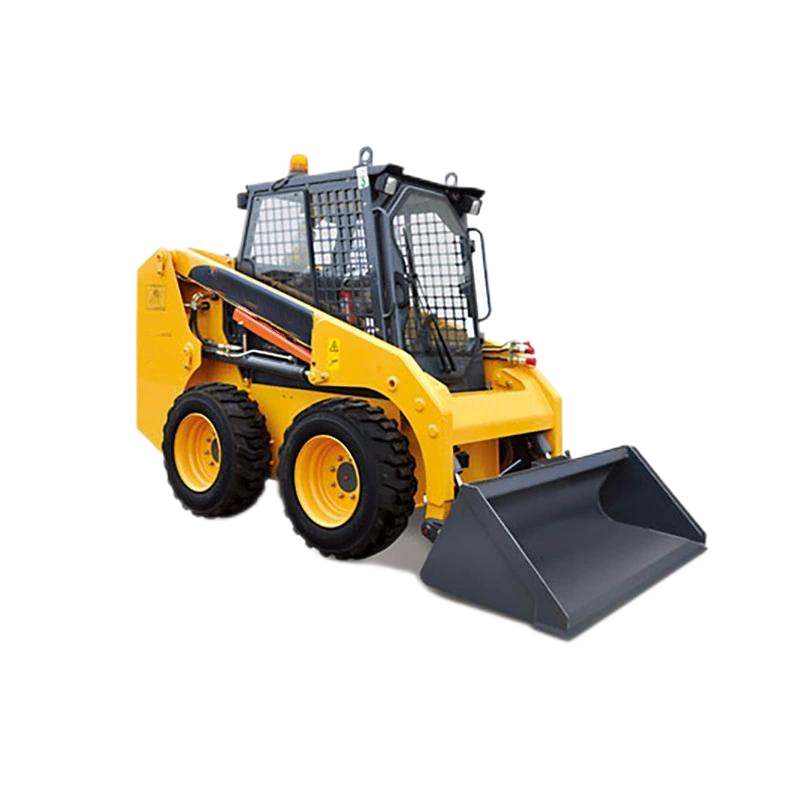Both skid steer loaders and backhoe loaders (also known as excavating loaders, commonly called "two-way machines") are small multi-functional construction machinery commonly used in engineering construction, but they have significant differences in structural design, functional focus, applicable scenarios, etc. The following is a detailed comparison of the two from multiple dimensions:

I. Differences in Core Structure and Appearance
Skid Steer Loader
- Overall structure: The body is compact, with no obvious "separation" design between the cab and the working device. Working devices (such as buckets, breakers, etc.) are directly installed at the front of the body. It achieves extremely high flexibility through "skid steering" of the tracks or tires on both sides (steering is realized by reverse rotation of the walking mechanisms on both sides).
- Cab: Usually of closed or semi-closed design, located in the middle of the body, with the field of vision focused on the front working device.
- Walking mode: Mostly wheeled (suitable for hard ground) or tracked (suitable for soft ground), with wheeled being the mainstream. It has a small ground contact area but strong mobility.
Backhoe Loader
- Overall structure: The body is divided into front and rear parts. The front end is a loader working device (bucket), and the rear end is an excavator working device (boom, stick, bucket). The two parts are connected by a rotating or articulated structure, enabling the switching between "loading at one end and excavating at the other".
- Cab: Located in the middle of the body, allowing two-way operation (controlling the front and rear working devices respectively). Some models have a rotating cab to facilitate switching of the operating perspective.
- Walking mode: Mainly wheeled, with a larger ground contact area. It has better stability than skid steer loaders and is suitable for working on uneven ground.
II. Functional and Operational Focus
| Dimension | Skid Steer Loader | Backhoe Loader |
|---|---|---|
| Core function | Focuses on "multi-functional operations at the front end", such as shoveling, handling, leveling, crushing, etc. | Combines "front-end loading" and "rear-end excavating", capable of completing earth excavation and transfer simultaneously. |
| Operation depth | No excavating function, unable to perform deep pit or vertical earthwork operations. | The rear excavating device can achieve excavation of foundation pits several meters deep, suitable for underground projects. |
| Flexibility | Compact body (usually 3-4 meters in length), can work in narrow spaces (such as indoors, roadways) with an almost zero turning radius. | Longer body (usually 5-7 meters in length), steering relies on the articulated structure. It is less flexible than skid steer loaders but has a wider operating range. |
| Accessories | Can quickly replace dozens of attachments (such as forks, snow brushes, hydraulic shears, etc.), with extremely strong versatility. | Attachment replacement mainly includes buckets and breakers, focusing on earth-related operations, with slightly weaker versatility. |
III. Applicable Scenarios
Typical scenarios for skid steer loaders
- Narrow space operations: Such as indoor backfilling in construction sites, basement cleaning, roadway maintenance.
- Multi-functional auxiliary operations: Road surface crushing and garbage handling in municipal engineering, material loading/unloading and site leveling in agriculture.
- Scenarios requiring high flexibility: Short-distance transportation in warehouses and docks, garden pruning, snow removal, etc.
Typical scenarios for backhoe loaders
- Comprehensive earthwork operations: Foundation pit excavation + earth transfer in small infrastructure projects, leveling of rural homesteads, ditch digging.
- Outdoor engineering: Slope trimming beside highways, pipeline laying (excavation + backfilling), short-distance earth transportation in mines.
- Scenarios with high demand for "integrated excavating + loading" operations: Avoid frequent equipment replacement and improve construction efficiency.
IV. Power and Performance Parameters
- Power: Both are powered by diesel engines, with overlapping power ranges (mostly 30-100 horsepower). However, backhoe loaders usually have higher fuel consumption because they need to drive two sets of working devices (front and rear).
- Rated load capacity: Skid steer loaders have a smaller load capacity (usually 0.5-2 tons), while backhoe loaders have stronger front-end loading capacity (1-3 tons).
- Digging force: The bucket digging force of the rear excavating device of backhoe loaders can reach several tons, while skid steer loaders do not have this parameter.
V. Summary: How to Choose?
If you need to work in narrow spaces or frequently replace attachments to complete diversified auxiliary tasks (such as crushing, cleaning), priority should be given to skid steer loaders.
If the project involves integrated excavating + loading operations (such as directly transferring earth after digging a ditch) or requires medium-depth excavation in open outdoor spaces, priority should be given to backhoe loaders.
The two are not substitutes but complements: For small projects, you can choose one according to core needs; large construction sites often equip both, with each responsible for fine auxiliary operations and comprehensive earthwork operations respectively.





